
Darwinia, sometimes commonly known as mountain bells or simply bells, is a genus of about 70 species of evergreen shrubs in the family Myrtaceae, endemic to southeastern and southwestern Australia. The majority are native to southern Western Australia, but a few species occur in South Australia, New South Wales and Victoria. The genus was named in honour of Erasmus Darwin, grandfather of Charles Darwin by Edward Rudge in 1816. Most darwinias grow to a height of between 0.2 and 3 m, and many are prostrate shrubs. Most have small, simple leaves and the flowers are often grouped together, each flower with five red, white or greenish petals and ten stamens. In many species, the flowers are surrounded by large, colourful bracts, giving rise to their common names.

Darwinia taxifolia is a species of flowering plant in the myrtle family Myrtaceae and is endemic to New South Wales. It is an erect or low-lying shrub with laterally compressed leaves. The flowers are pink or purplish and usually arranged in groups of two to four.
Kunzea peduncularis, commonly known as mountain burgan, is a flowering plant in Myrtaceae, the myrtle family, and is endemic to Victoria, Australia. It is usually a dense shrub and has lance-shaped to egg-shaped leaves with the narrower end towards the base. Dense groups of white flowers appear in early summer.

Darwinia glaucophylla is a plant in the myrtle family Myrtaceae which grows as a prostrate shrub, sometimes forming extensive mats. It has bluish green leaves and white flowers in small groups which fade to reddish pink as they age. It is only known from about fifteen sites in the Gosford area and is listed as "threatened" in New South Wales legislation.

Darwinia fascicularis is shrub in the myrtle family and is endemic to areas near Sydney. A small shrub with aromatic foliage and white flowers, turning red as they mature. Nectar feeding birds are attracted to its flowers as a food source.

Bauera microphylla is a species of flowering plant in the family Cunoniaceae and is endemic to New South Wales. It is a small shrub with trifoliate, sometimes toothed leaves, and usually white, pedicellate flowers.
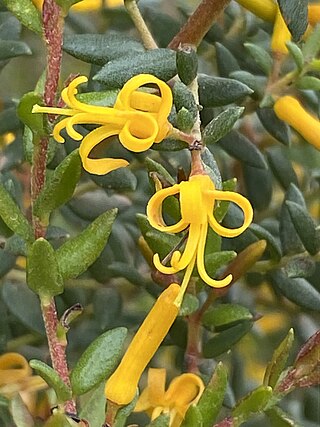
Persoonia mollis, commonly known as soft geebung, is a plant in the family Proteaceae and is endemic to New South Wales. It is an erect to prostrate shrub with linear to oblong or spatula-shaped leaves, yellow flowers in groups of up to thirty on a rachis up to 150 mm (5.9 in) long and relatively small fruit.

Homoranthus darwinioides, commonly known as fairy bells, is a species of flowering plant in the family, Myrtaceae. It is a small, spreading shrub with pendulous yellow and pink flowers, grey-green leaves and is endemic to New South Wales.
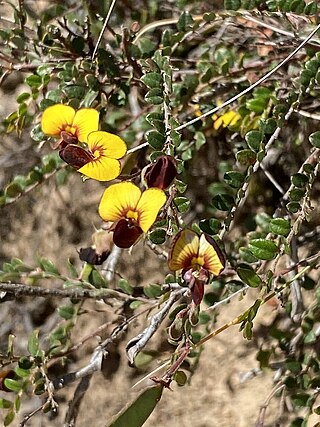
Bossiaea prostrata, commonly known as creeping bossiaea, is a prostrate understory shrub in the pea family, Fabaceae. It is a widespread species with orange-yellow flowers, purple-brown keels and trailing branches.

Darwinia grandiflora is a flowering plant in the family Myrtaceae. It is a dense, mat forming, prostrate shrub with clusters of tubular red flowers and is endemic to New South Wales.

Darwinia biflora is a plant in the myrtle family Myrtaceae and is endemic to New South Wales. It is an erect, often straggly shrub with flattened, glabrous leaves, and flowers which are arranged in pairs. The flowers are greenish in colour but each is surrounded by two purple-red bracteoles and have a long yellow-green style projecting out of the flower tube. The species only occurs in the Sydney region in a few places where shale-capped ridges intergrade with Hawkesbury sandstone.
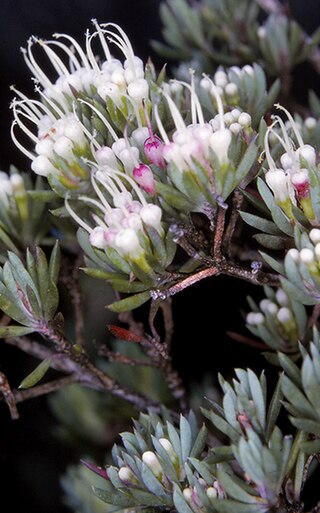
Darwinia camptostylis is a plant in the myrtle family Myrtaceae and is endemic to New South Wales and Victoria. It is small shrub with flattened, glabrous leaves and small clusters of green to yellow flowers. There are scattered populations in coastal areas where the plants grow in heath.

Darwinia speciosa is a plant in the myrtle family Myrtaceae and is endemic to the southwest of Western Australia. It is a dwarf, spreading or prostrate shrub with narrowly oblong leaves arranged in opposite pairs, and greenish flowers surrounded by larger dark red or brownish involucral bracts.

Darwinia thymoides is a species of flowering plant in the myrtle family Myrtaceae and is endemic to the south-west of Western Australia. It is a low, spreading to prostrate shrub with linear to lance-shaped leaves and groups of 4 to 8 green, red or white flowers surrounded by leaf-like bracts.
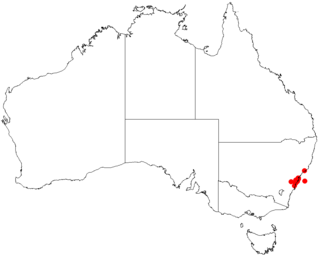
Darwinia diminuta is a plant in the myrtle family Myrtaceae and is endemic to New South Wales. A small spreading shrub with white to pinkish tubular flowers arranged in pairs, with a restricted distribution mostly in the Sydney region.
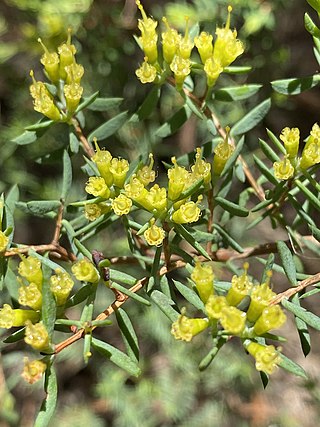
Homoranthus lunatus, commonly known as crescent-leaved homoranthus, is a flowering plant in the family Myrtaceae and is endemic to a small area in northern New South Wales. It is a spreading shrub with curved leaves and small groups of up to six yellow flowers in leaf axils.

Pultenaea blakelyi, commonly known as Blakely's bush-pea, is a species of flowering plant in the family Fabaceae and is endemic to south-eastern continental Australia. It is an erect shrub with sharply-pointed, narrow elliptic to egg-shaped leaves and yellow to orange flowers in open clusters in leaf axils or at the ends of branches.

Pimelea curviflora, also known as curved rice-flower, is a shrub in the family Thymelaeaceae and is endemic to Australia. It is a small, hairy shrub with greenish-yellow or red tubular flowers.
Bursaria cayzerae is a species of flowering plant in the family Pittosporaceae and is endemic to the North Coast of New South Wales. It is a sparsely-branched shrub with spiny branches, narrowly elliptic leaves, flowers with five glabrous sepals, spreading white petals and five stamens, and flattened fruit.

Darwinia leptantha is a flowering plant in the family Myrtaceae. It is an upright, small shrub with white flowers turning pink with age, triangular-shaped leaves and is endemic to New South Wales.



















